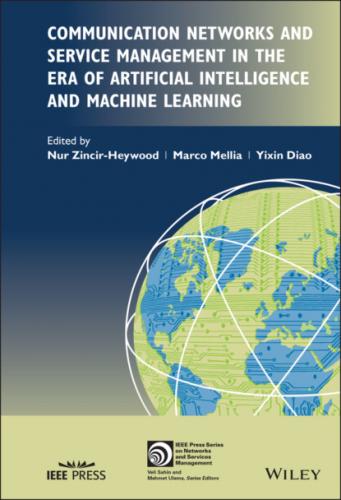Ghent University – imec, IDLab
Ghent, Technologiepark‐Zwijnaarde
Oost‐vlaanderen, Belgium
Luca Vassio
Politecnico di Torino
Torino, Italy
Tim Wauters
Department of Information Technology
Ghent University – imec, IDLab
Ghent, Technologiepark‐Zwijnaarde
Oost‐vlaanderen, Belgium
Johannes Zerwas
Chair of Communication Networks
Department of Electrical and Computer Engineering
Technical University of Munich
Munich, Germany
Engin Zeydan
Communication Networks Division
Centre Tecnológic de Telecomunicacions Catalunya (CTTC/CERCA)
Barcelona, Spain
Nur Zincir‐Heywood
Faculty of Computer Science
Dalhousie University
Halifax, Nova Scotia, Canada
Thomas Zinner
Department of Information Security and Communication Technology
Norwegian University of Science and Technology
Trondheim, Norway
Preface
Advances in artificial intelligence and machine learning algorithms provide endless possibilities in many different science and engineering disciplines including computer communication networks. Research is therefore needed to understand and improve the potential and suitability of artificial intelligence and machine learning in general for communications and networking technologies and research, but also in particular systems and networks operations and management. Approaches and techniques such as artificial intelligence, data mining, statistical analysis, and machine learning are promising mechanisms to harness the immense stream of operational data in order to improve the management and security of IT systems and networks. This will not only provide deeper understanding and better decision‐making based on largely collected and available operational data but will also present opportunities for improving data analysis algorithms and methods on aspects such as accuracy, scalability, and generalization.
This book will focus on recent, emerging approaches, and technical solutions that can exploit artificial intelligence, machine learning, and big data analytics for communications networks and service management solutions. In this context, the book is intended to be a reference book for information and communications technology educators, engineers, and professionals, in terms of presenting a picture of the current landscape and discussing the opportunities and challenges of this field for the future. It is not intended as a textbook. Having said this, it can be used as a reference text for related graduate courses or high‐level undergraduate courses on topic.
This book is composed of three parts and 13 chapters that provide an in‐depth review of current landscape, opportunities, challenges, and improvements created by the artificial intelligence and machine learning techniques for network and service management.
The first part, Introduction, gives a general overview of the network and service management research as well as the artificial intelligence and machine learning techniques.
Chapter 1, Overview of Network and Service Management, outlines the field of network and service management that involve the setup, configuration, administration, and management of networks and associated services to ensure that network resources are effectively made available to customers and consumed as efficiently as possible by applications.
Chapter 2, Overview of Artificial Intelligence and Machine Learning, overviews the AI/ML algorithms that are most commonly used in the network and service management field, and discusses the strategic areas within network and services management that evidence growing interest of the community in developing cutting edge AI/ML solutions.
The second part of the book, Management Models and Frameworks, is dedicated to important management models and frameworks such as virtualized networks, 5G networks, and fog computing.
Chapter 3, Managing Virtualized Networks and Services with Machine Learning, exposes the state‐of‐the‐art research that leverages Artificial Intelligence and Machine Learning to address complex problems in deploying and managing virtualized networks and services. It also delineates open, prominent research challenges and opportunities to realize automated management of virtualized networks and services.
Chapter 4, Self‐Managed 5G Networks, discusses the main challenges that must be faced to successful develop 5G systems, focusing particularly on radio access networks, optical networks, data plane management, network slicing, and service orchestration, and highlights autonomous data‐driven network management and federation among administrative domains that are critical for the development of 5G‐and‐beyond systems.
Chapter 5, AI in 5G Networks: Challenges and Use Cases, covers three representative case studies including QoE assessment, deployment of virtualized network functions, and slice management. It further points out general and use case‐specific requirements and challenges and derives guidelines for network operators who plan to deploy such mechanisms.
Chapter 6, Machine Learning for Resource Allocation in Mobile Broadband Networks, provides an in‐depth review of the existing machine learning techniques that have been applied to wireless networks in the context of wireless spectrum and power allocations, user scheduling, and user association.
Chapter 7, Reinforcement Learning for Service Function Chain Allocation in Fog Computing, explores the use of reinforcement learning as an efficient and scalable solution for service function chaining, especially given the dynamic behavior of the network and the need for efficient scheduling strategies, as compared to the state‐of‐the‐art integer linear programming‐based implementations.
The third part of the book, Management Functions and Applications, is focused on vital management function and applications including performance management, security management, and Blockchain applications.
Chapter 8, Designing Algorithms for Data‐Driven Network Management and Control: State‐of‐the‐Art and Challenges, provides an overview of approaches that use machine learning and artificial intelligence to learn from problem solution pairs to improve network algorithms. It discusses the applicability for different use cases and identifies research challenges within those use cases.
Chapter 9, AI‐Driven Performance Management in Data‐Intensive Applications, overviews recurring performance management activities for data‐intensive applications and examines the role that AI and machine learning are playing in enhancing configuration optimization, performance anomaly detection, load forecasting, and auto‐scaling of software systems.
Chapter 10, Datacenter Traffic Optimization with
